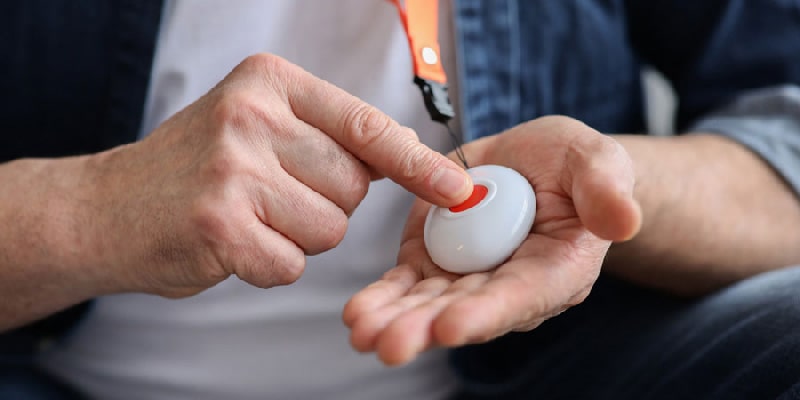Preventing a devastating fall is a top priority for seniors. As mobility declines with age, everyday tasks become more dangerous, but a wearable alert device can help.
A wearable alert device is a small electronic product that features an easy-to-push button. Seniors can press this button if they’re in an emergency, such as falling in their homes.
How These Devices Work
While some of these devices have more features, the main premise involves pressing a button to call for help. The user simply hits the button to contact an emergency responder to use the device. The alert button is typically the most prominent button on these gadgets.
After you push the button, the unit will automatically call the response center associated with the alert service provider. Then, you’ll usually hear a series of loud beeps until you’re connected. A live representative will then answer the call after around 30 seconds.
Like a hands-free device, the user can simply talk and ask for help. If immediate assistance is needed, the agent will call 911 to dispatch a local emergency responder to the home.
Related: 8 Solutions for Fall Prevention in Cold Weather
Different Types of Wearable Devices
While wearable alert devices all have the same basic principle, there are different varieties. Also, some come with more features and capabilities than others.
Take a look at the different types of wearable alert devices on the market today:
Home Use Devices
These wearable devices are mainly used inside the home, and they’re connected via landline or cellular connection. They are cost-effective, with some selling for as little as $5 to $10 a month. These wearable devices often include long battery life and waterproof design. These devices can be worn comfortably inside the home.
Mobile Gadgets
While staying safe inside your home is vital, it’s also important while on the road or running errands. Luckily, several mobile wearable devices work with a cellular connection. This option is great for anywhere there’s cell service. Also, as these mobile devices are often connected to GPS, emergency responders can easily find your location.
Smartwatches
While a device worn around the neck is beneficial for seniors, it can be bulky and uncomfortable for some people. Some seniors may prefer a smartwatch that can function as a medical alert device. These comfortable, discreet options work just like the wear-around-the-neck models.
Benefits of Wearable Alert Devices
Wearable alert devices offer several benefits for seniors. As many people in the senior community live alone, these devices can be a lifeline when seniors need it most. For example, if a senior falls inside their home, emergency responders can show up in minutes with the touch of a button.
Here are more advantages of wearable alert devices:
Potentially Life-Saving
According to the CDC, around 36,000 older adults experience a fall every year in the United States. Unfortunately, this results in over 32,000 deaths, and why these convenient wearable devices are essential. Quickly responding can save a life when a senior experiences a fall and can’t get up. With the touch of a button, wearable devices save countless lives every year.
Easy to Use
The wearable alert devices of today are very easy to use. Whether worn over the neck or on the wrist, these gadgets work by simply pressing a large ‘help’ button. Additionally, the one-button design makes the device less confusing. Having only one button can make the situation less stressful when there’s an emergency.
Convenient
These wearable alert devices are incredibly convenient. When there’s an emergency, users don’t have to worry about finding a phone — they simply press the large button on their wearable device. Also, as many falls happen in the bathroom, these devices are typically waterproof and drop-proof.
Cost-Effective
Wearable alert devices aren’t free, but they don’t include a hefty price tag. While the different types have different price points, it’s important to consider the best device for your needs. If you’re looking for an in-home device, these typically cost between $20 to $50 per month. For mobile versions, expect to pay $25 to $60 monthly. If you’re interested in a wearable smartwatch, these are roughly the same price. Expect to pay between $25 to $45 monthly.
Added Features To Consider
While these products are great already, some added features can make them even more impressive. Automatic fall detection is a leading add-on, a feature that automatically detects when a fall occurs, and you don’t even need to hit the button after falling. GPS tracking is another popular add-on used primarily for people on the go. These systems give first responders your exact location when you need help.
For seniors, wearable alert devices can help save a life. If you’re worried about your senior loved one’s safety at home or out on their own, a wearable alert device can provide peace of mind that someone will respond quickly in case of an emergency.





